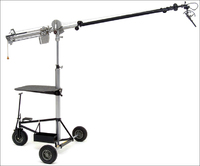It should go without saying that the right tools are a necessity for doing a good job.

The recorder is a portable digital recorder, two or more tracks, and often with timecode. On feature films, it is not uncommon to see two recorders on the soundcart: a multi-track deck for recording isolated tracks; and a simpler two-track recorder for dailies and the picture-cut. Sometimes a soundtrack may be simultaneously recorded in the video camera. Always try to monitor out of the record deck rather than the mixing panel, in case of RF interference or ground loops.
The mixing panel is of paramount importance. On a set, it is not so often a question of mixing a large number of inputs as it is being able to exert control over one or two. A good panel should offer four to eight inputs (rarely will you ever need more than that), limited equalization, lots of input gain, and a communications module.
EQ is hardly used, except for bass roll-off and a slight mid-range boost to help punch the dialogue. Anything more than that is best achieved during post-production. Signal processing does not belong on the set; it should be done later on in the 'million dollar rooms" during final re-recording. Films are shot out of sequence, with shots being torn apart and edited together to create finished scenes. Attempts to prematurely process the track can cause a myriad of matching problems.
Much of production mixing consists of riding gain on a mic, leveling out the extremes of each character as well as balancing between multiple characters. Smooth ramping or slope is essential in a pot or fader to accomplish this feat inaudibly. Most of the compact sized ENG-style mixing boxes fall short for this function. Not only are their mini-knobs too small for human fingers, but even slight gain adjustments call attention to themselves on the track.
In terms of the communications module, a mixing panel should have a slate mic (possibly with sub-tone slating if one is working in film), a talk-back for communication with the boom man during a take, audio returns for the boom men, and a 1-K tone oscillator for setting reference levels.
If you are working in video, then be very cautious of all electrical connections (VTR, monitor, and camera) that may cause ground loops and induce noise into the track. (Note: electrical interference can be induced via BNC video connectors; not just power or audio.)
Microphones should be of true condenser type, 48v Phantom. Good shockmounts and blimp-type windscreens are a must. Patterns should include a long shotgun, a short shotgun, and a wideer angle cardioid. Avoid being saddled with the less expensive, electret condenser capsule systems that are so much in vogue with the video people. These systems, though wonderful for their price, lack the sensitivity and reach offered by "real" condensers.
Lavalieres come in two basic varieties, transparent or proximity oriented. In the old days, all of your professional grade electret lavalieres were proximity oriented. That is, they tended to add presence to close dialogue while rejecting background ambience -- which was fine for newscasters and spokesman. Many of the newer mini-lavalieres offer a more transparent sound, allowing them to blend in more naturally with overhead boom mics or to function as plant mics. The drawback is that the transparent lavs also pass more ambience. Depending on the situation, both varieties have their uses.
Radio mics are an option. They are expensive, and even the best of them can be unreliable due to outside factors (such as RF interference, magnetic voodoo, etc.). However, there will be instances when the sound is either gotten off of radios or not at all. If you plan on needing radios, budget for more units than what you expect to use. Otherwise, what do you do if a unit breaks?
 Boompole selection is very important. They should extend to 12 or 18 feet. A pole should be lightweight, but not to the point of bowing under the weight of a mic, shockmount, and windscreen at full extension. Struggling all day with a bending boompole will wreak havoc on a boom man’s back. Also, make sure that the locking mechanisms and internal mic cable does not rattle when the pole is moved. There is a reason that good boompoles are expensive.
Boompole selection is very important. They should extend to 12 or 18 feet. A pole should be lightweight, but not to the point of bowing under the weight of a mic, shockmount, and windscreen at full extension. Struggling all day with a bending boompole will wreak havoc on a boom man’s back. Also, make sure that the locking mechanisms and internal mic cable does not rattle when the pole is moved. There is a reason that good boompoles are expensive.
Studio booms, such as the Fisher, are actually rather inexpensive to rent and should be seriously considered for many non-documentary productions. Their ability to telescope over distances and cue make them highly versatile on a set. Budget extra, though, for an experienced boom operator to run it.
